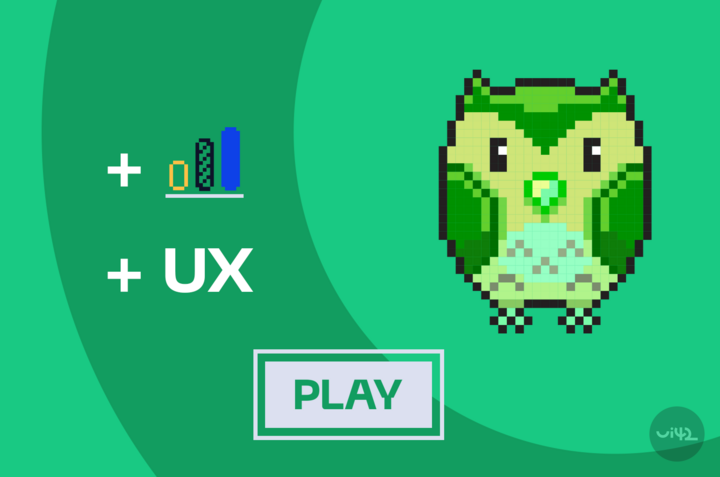Gamification is one of many strategies to gain and maintain user interest on a website. Does this term evoke the idea of a game in you? Actually, you are not far from the truth at all. However, the reason why we delve into gamification has a somewhat deeper meaning than just superficial entertainment. Gamification online increases interest, interaction, time spent on the site or in the app, and even conversions.

What is gamification?
Gamification refers to the application of game and entertainment principles in environments that are not exclusively intended for these purposes. Examples include education, HR, marketing, the financial sector, social networks, science and research, or commerce. Simply anywhere where elements of play and fun can achieve the goal we are pursuing.
What are the elements of gamification?
You have certainly encountered them in several of the above-mentioned environments. If you are educating yourself online using some application, it is quite possible that you are overcoming levels or collecting points.
A pioneer of this tactic is the well-known application Duolingo, where a green owl accompanies language learning for more than 500 million users! According to a case study and UX research, it has been confirmed that users spend time in the application often not with the goal of learning something new, but to maintain their position, which is precisely the result of gamification.
What other elements, besides competition, does this strategy use?
- rewards
- points
- levels and tiers
- challenges
- feedback and praise
- social interaction within the community
- quizzes, discount wheels
- flash offers
- and many others
Why does gamification act like a magnet?
All these activities, achieving levels and collecting rewards, affect the subconscious of a person, through psychology, motivation, and ambitions. According to sources as much as 89% of users spend more time within an application if it contains elements of gamification. And that is indeed an interesting number.
An even more precise explanation is that gamification uses mechanisms that stimulate the release of dopamine in the brain. As soon as we achieve a reward, new points are added to our account or we move to the next level, our hypothalamus releases the neurohormone dopamine and we are flooded with a wave of satisfaction and joy. And so on and so forth.
The feeling of success and the cherry on top in the form of a reward, fun and a paradise for competitive natures, all served on a golden platter within community sharing. It's hard to resist. And the most successful players and well-known brands know this.
Which companies use gamification online?
You may be surprised to learn that out of the 2000 most successful companies in the world as many as 70% use elements of gamification. For marketing, recruiting new employees, internal activities, or increasing metrics directly in the application or on the website. Which of them, besides the popular Duolingo, have managed to make the most of it online?
Interland by Google
Interland is a great initiative directly from the giant Google, whose goal is to educate about the dangers and safety on the internet through interactive elements, puzzles, and games. It gets extra points for being created primarily for children, who can thus learn in a playful way how to behave and protect themselves in the online environment.
Playspent for financial literacy
Although once again an educational platform, it has an even more virtuous message. Playspent combines gamification, stories, and emotions. And those who have to make every single dollar or euro count. Thanks to modeled situations, the website can educate on solving problems of the socially weaker layers, whose members often face job loss, low income, and reckless spending or constant indebtedness.
Running by Adidas or Runkeeper by Asics
Running? Then you know them. If you don't run but would like to, with them, it will be a breeze. Running apps are a great example of gamification that people use more and more. Achieving badges, monthly challenges, personal progress, and training, along with the support of a community that will praise you for your successes, is an incredible motivator to overcome your goals.
Myntra as a Gamification Pro in Retail
As early as 2019, the Indian fashion site Myntra used gamification in a sophisticated marketing campaign. Its goal was to increase brand awareness, boost sales, and engage more users within the app. By earning points through in-app games, people could win rewards. The result? During the campaign, the app reached an incredible 650,000 users.
TEMU - Shop (and Play) Like a Billionaire
We can't leave out the orange shopping network from this list. Gamification is woven throughout it. Bonuses, coupons, rewards for reviews, and special limited-time offers... Tick-tock, do you also succumb to them? The reason is the subconscious feeling of urgency that the seller creates with a "limited offer" using a timer or a countdown of pieces. If we add various animations, a distracting environment like in a shop window or a casino, and social proof in the form of references, we have a set of gamification elements that work on people almost like an addiction.
What are the benefits of gamification on a website or in an app?
Within internal processes and HR, gamification can mean more efficient selection of potential employees and also setting up benefits. In e-commerce, more specifically in marketing and sales activities, we mainly monitor user interactions with the site/app and important metrics.
What kind, for example?
- Increased engagement with the site
- Building loyalty to the website
- More conversions
- Better UX (user experience)
- More time spent on the site and thus better SEO
- Data acquisition
- Building a community
- Building a brand and awareness
- Motivation to purchase/order services
In other words, gamification can transform a website or app into a place where users like to go. They can share their experiences with their friends or seek support in a new community of people, thereby gaining a sense of belonging to a larger whole. They are motivated to make purchases through rewards, points, or achieving certain levels. Challenges and time constraints accelerate decision-making, whether to buy or fill out a form, and they will do it all again and again with a well-set gamification strategy. That's why gamification in online marketing is a great way to reach new customers, encourage visitor interactions, keep them on the website, and engage them enough to come back again.
Okay. But how do you do that?
5 Steps to Applying Gamification Online
As in most cases, there is no universal answer for everyone. Gamification also requires its own unique strategy to be effective. The nature of your online business, product or service, as well as the target group and many other factors come into play. However, we have summarized five steps that you should not miss when implementing game elements into your website or app.
Get to know your target group
If you've been in e-commerce for a while, you probably know that the target group is not just a phrase that marketers made up. The better you know your customer, the better you understand their desires and needs. If we want to tailor it to gamification, the better you know if they like to have fun, what motivates them to visit your website, whether they are motivated by socialization or relaxation, or perhaps by learning and achieving new levels.
Choose the right strategy and gamification elements
After considering and evaluating the first step, it's time to choose the gamification elements. We are talking about points, badges, leaderboards, challenges, and other aforementioned options that will increase the target group's interaction with the website or app.
Invent and clearly define the entire system
All these elements must have logic and mutual connection. Basically, imagine that you are really inventing and developing a game. If you use points, clear conditions must be set for how to earn them and further convert them into benefits. Users can earn points for activity or for achieving certain goals. They can exchange them for rewards, or they can reflect some level or position within the game. Then follow the levels or stages of the game, which should be proportionally challenging, and finally a clear win - a discount, certificate, voucher. However you come up with it, it has to make sense.
Implement elements into the website/app
Don't forget to give them an attractive graphic design and place them in the right places. Examples include discount wheels or flash sales. For app notifications, use effective UX writing. For badges, clearly distinguish between levels, and so on. Ideally, it should be a unique and unified visual of the elements in line with the identity of the brand or project.
Analyze and refine gamification to the detail
Finally, there is one more important thing. Analyze the data and monitor the selected metrics that gamification was supposed to achieve. Whether people added more products to their carts, whether they spend more time on the website, filled out more forms, recommend the website, mention it on social networks, whether the number of app downloads has increased, etc. After all, the implementation of gamification elements does not end there, there is always a possibility to improve the user experience.
Do you already have a bunch of ideas in your head about how to use gamification in your business? Or, on the contrary, do you see the potential but don't know how to turn it into your competitive advantage? Contact us, at ui42 we have experts in every area of e-commerce, we are happy to tailor a solution for you. From the idea to the design and implementation.














